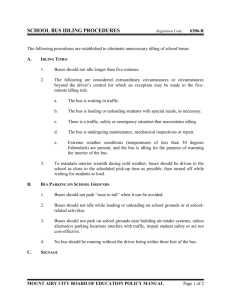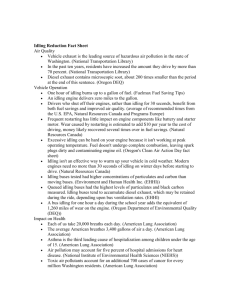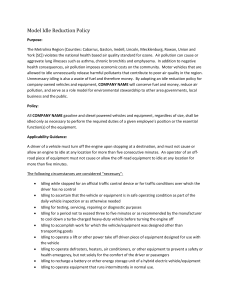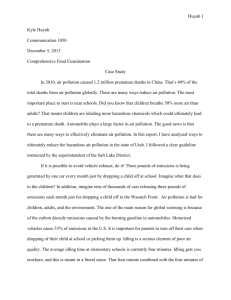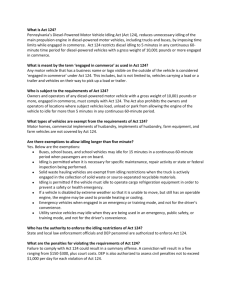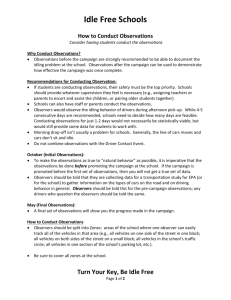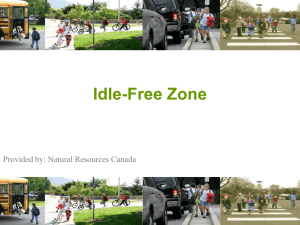Benefits of Reducing School Bus Idling
advertisement
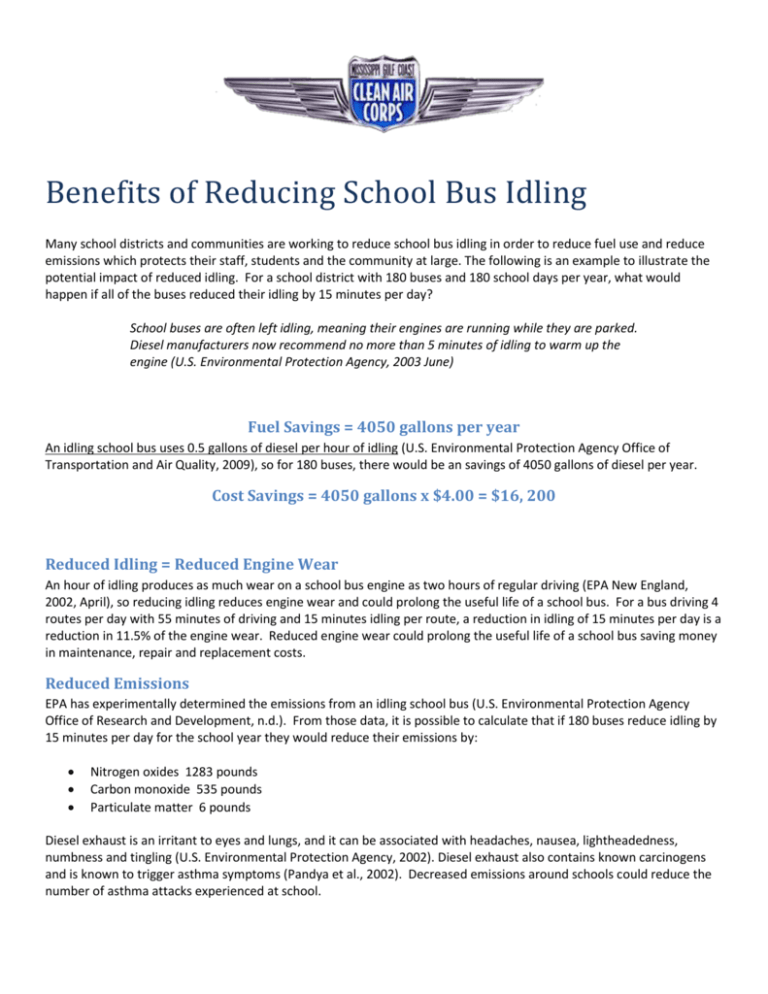
Benefits of Reducing School Bus Idling Many school districts and communities are working to reduce school bus idling in order to reduce fuel use and reduce emissions which protects their staff, students and the community at large. The following is an example to illustrate the potential impact of reduced idling. For a school district with 180 buses and 180 school days per year, what would happen if all of the buses reduced their idling by 15 minutes per day? School buses are often left idling, meaning their engines are running while they are parked. Diesel manufacturers now recommend no more than 5 minutes of idling to warm up the engine (U.S. Environmental Protection Agency, 2003 June) Fuel Savings = 4050 gallons per year An idling school bus uses 0.5 gallons of diesel per hour of idling (U.S. Environmental Protection Agency Office of Transportation and Air Quality, 2009), so for 180 buses, there would be an savings of 4050 gallons of diesel per year. Cost Savings = 4050 gallons x $4.00 = $16, 200 Reduced Idling = Reduced Engine Wear An hour of idling produces as much wear on a school bus engine as two hours of regular driving (EPA New England, 2002, April), so reducing idling reduces engine wear and could prolong the useful life of a school bus. For a bus driving 4 routes per day with 55 minutes of driving and 15 minutes idling per route, a reduction in idling of 15 minutes per day is a reduction in 11.5% of the engine wear. Reduced engine wear could prolong the useful life of a school bus saving money in maintenance, repair and replacement costs. Reduced Emissions EPA has experimentally determined the emissions from an idling school bus (U.S. Environmental Protection Agency Office of Research and Development, n.d.). From those data, it is possible to calculate that if 180 buses reduce idling by 15 minutes per day for the school year they would reduce their emissions by: Nitrogen oxides 1283 pounds Carbon monoxide 535 pounds Particulate matter 6 pounds Diesel exhaust is an irritant to eyes and lungs, and it can be associated with headaches, nausea, lightheadedness, numbness and tingling (U.S. Environmental Protection Agency, 2002). Diesel exhaust also contains known carcinogens and is known to trigger asthma symptoms (Pandya et al., 2002). Decreased emissions around schools could reduce the number of asthma attacks experienced at school. School Bus Idling Calculator: www.epa.gov/cleanschoolbus/idle_fuel_calc.htm The below results are based on the idling habit on one (1) school bus and an average fuel cost of $4.00 per gallon. Minutes of Reduction Per Day 5 10 15 20 30 45 60 Annual Fuel Savings (gallon) 7.5 15 22.5 30 45 67.5 90 Annual Cost Savings Per Bus $30.00 $60.00 $90.00 $120.00 $180.00 $270.00 $360.00 Support for the Program Ways the schools can support a no-idling policy. 1. Have drivers turn off their engines immediately upon arrival on campus 2. Arrange your pick up line so that queued buses are not pumping exhaust into the one behind them 3. Limit idling time for buses in the morning pick-up and afternoon drop off 4. Provide a space inside the school for drivers to wait with heat or air conditioning 5. Upgrade your buses as possible to cleaner alternatives and ensure that 4each is wired or rewired to allow the flashing lights and safety features to function while the key is off and the door is open References: EPA New England. (2002, April). What you should know about truck engine idling. Boston, MA. Pandya, R. J., Solomon, G., Kinner, A., Balmes, J. R., Pandya, R. J., Solomon, G., et al. (2002). Diesel exhaust and asthma: hypotheses and molecular mechanisms of action. [Review]. Environmental Health Perspectives, 110 Suppl 1, 103-112. U.S. Environmental Protection Agency. (2002). Health assessment document for diesel engine exhaust (EPA/600/890/057F). Retrieved July 16, 2010. from http://cfpub.epa.gov/ncea/cfm/recordisplay.cfm?deid=29060. U.S. Environmental Protection Agency. (2003, June). Diesel exhaust and school bus idling (No. EPA420-F-03-021). Washington, D.C. U.S. Environmental Protection Agency Office of Research and Development. (n.d.). Characterization of the fine particle and gaseous emissions from school bus idling. Retrieved July 16, 2010, from http://www.epa.gov/Region2/cleanschoolbus/r2schoolbusstudy.pdf U.S. Environmental Protection Agency Office of Transportation and Air Quality. (2009, January 6). Clean school bus USA. Retrieved July 16, 2010, from http://www.epa.gov/cleanschoolbus/antiidling.htm
